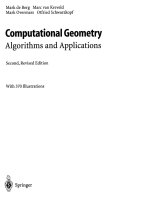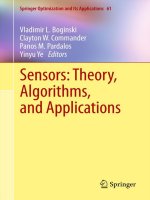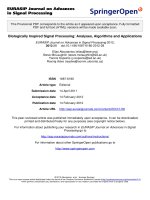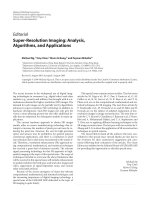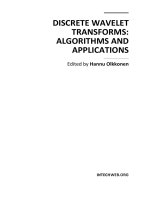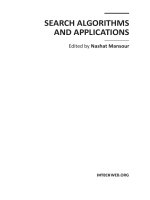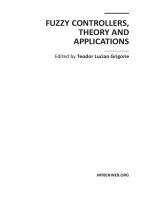SEARCH ALGORITHMS AND APPLICATIONS pps
Bạn đang xem bản rút gọn của tài liệu. Xem và tải ngay bản đầy đủ của tài liệu tại đây (20.06 MB, 504 trang )
SEARCH ALGORITHMS
AND APPLICATIONS
Edited by Nashat Mansour
Search Algorithms and Applications
Edited by Nashat Mansour
Published by InTech
Janeza Trdine 9, 51000 Rijeka, Croatia
Copyright © 2011 InTech
All chapters are Open Access articles distributed under the Creative Commons
Non Commercial Share Alike Attribution 3.0 license, which permits to copy,
distribute, transmit, and adapt the work in any medium, so long as the original
work is properly cited. After this work has been published by InTech, authors
have the right to republish it, in whole or part, in any publication of which they
are the author, and to make other personal use of the work. Any republication,
referencing or personal use of the work must explicitly identify the original source.
Statements and opinions expressed in the chapters are these of the individual contributors
and not necessarily those of the editors or publisher. No responsibility is accepted
for the accuracy of information contained in the published articles. The publisher
assumes no responsibility for any damage or injury to persons or property arising out
of the use of any materials, instructions, methods or ideas contained in the book.
Publishing Process Manager Ivana Lorkovic
Technical Editor Teodora Smiljanic
Cover Designer Martina Sirotic
Image Copyright Gjermund Alsos, 2010. Used under license from Shutterstock.com
First published March, 2011
Printed in India
A free online edition of this book is available at www.intechopen.com
Additional hard copies can be obtained from
Search Algorithms and Applications, Edited by Nashat Mansour
p. cm.
ISBN 978-953-307-156-5
free online editions of InTech
Books and Journals can be found at
www.intechopen.com
Part 1
Chapter 1
Chapter 2
Chapter 3
Chapter 4
Chapter 5
Part 2
Chapter 6
Chapter 7
Chapter 8
Preface IX
Population Based and Quantum Search Algorithms 1
Two Population-Based Heuristic Search Algorithms
and Their Applications 3
Weirong Chen, Chaohua Dai and Yongkang Zheng
Running Particle Swarm Optimization
on Graphic Processing Units 47
Carmelo Bastos-Filho, Marcos Oliveira Junior
and Débora Nascimento
Enhanced Genetic Algorithm for Protein
Structure Prediction based on the HP Model 69
Nashat Mansour, Fatima Kanj and Hassan Khachfe
Quantum Search Algorithm 79
Che-Ming Li, Jin-Yuan Hsieh and Der-San Chuu
Search via Quantum Walk 97
Jiangfeng Du, Chao Lei, Gan Qin, Dawei Lu and Xinhua Peng
Search Algorithms for Image and Video Processing 115
Balancing the Spatial and Spectral Quality
of Satellite Fused Images through a Search Algorithm 117
Consuelo Gonzalo-Martín and Mario Lillo-Saavedra
Graph Search and its Application in Building Extraction
from High Resolution Remote Sensing Imagery 133
Shiyong Cui, Qin Yan and Peter Reinartz
Applied Extended Associative Memories to High-Speed
Search Algorithm for Image Quantization 151
Enrique Guzmán Ramírez, Miguel A. Ramírez
and Oleksiy Pogrebnyak
Contents
Contents
VI
Search Algorithms and Recognition
of Small Details and Fine Structures
of Images in Computer Vision Systems 175
S.V. Sai, I.S. Sai and N.Yu.Sorokin
Enhanced Efficient Diamond Search Algorithm
for Fast Block Motion Estimation 195
Yasser Ismail and Magdy A. Bayoumi
A Novel Prediction-Based Asymmetric
Fast Search Algorithm for Video Compression 207
Chung-Ming Kuo, Nai-Chung Yang,
I-Chang Jou and Chaur-Heh Hsieh
Block Based Motion Vector Estimation
Using FUHS16, UHDS16 and UHDS8 Algorithms
for Video Sequence 225
S. S. S. Ranjit
Search Algorithms for Engineering Applications 259
Multiple Access Network Optimization
Aspects via Swarm Search Algorithms 261
Taufik Abrão, Lucas Hiera Dias Sampaio, Mario Lemes Proença Jr.,
Bruno Augusto Angélico and Paul Jean E. Jeszensky
An Efficient Harmony Search Optimization
for Maintenance Planning to
the Telecommunication Systems 299
Fouzi Harrou and Abdelkader Zeblah
Multi-Objective Optimization Methods
Based on Artificial Neural Networks 313
Sara Carcangiu, Alessandra Fanni and Augusto Montisci
A Fast Harmony Search Algorithm
for Unimodal Optimization with Application
to Power System Economic Dispatch 335
Abderrahim Belmadani, Lahouaria Benasla and Mostefa Rahli
On the Recursive Minimal Residual Method
with Application in Adaptive Filtering 355
Noor Atinah Ahmad
A Search Algorithm
for Intertransaction Association Rules 371
Dan Ungureanu
Chapter 9
Chapter 10
Chapter 11
Chapter 12
Part 3
Chapter 13
Chapter 14
Chapter 15
Chapter 16
Chapter 17
Chapter 18
Contents
VII
Finding Conceptual Document Clusters
Based on Top-N Formal Concept Search:
Pruning Mechanism and Empirical Effectiveness 385
Yoshiaki Okubo and Makoto Haraguchi
Dissimilar Alternative Path Search
Algorithm Using a Candidate Path Set 409
Yeonjeong Jeong and Dong-Kyu Kim
Pattern Search Algorithms for Surface Wave Analysis 425
Xianhai Song
Vertex Search Algorithm of Convex Polyhedron
Representing Upper Limb Manipulation Ability 455
Makoto Sasaki, Takehiro Iwami, Kazuto Miyawaki,
Ikuro Sato, Goro Obinata and Ashish Dutta
Modeling with Non-cooperative Agents:
Destructive and Non-Destructive Search
Algorithms for Randomly Located Objects 467
Dragos Calitoiu and Dan Milici
Extremal Distribution Sorting Algorithm
for a CFD Optimization Problem 481
K.Yano and Y.Kuriyama
Chapter 19
Chapter 20
Chapter 21
Chapter 22
Chapter 23
Chapter 24
Pref ac e
Search algorithms aim to fi nd solutions or objects with specifi ed properties and con-
straints in a large solution search space or among a collection of objects. A solution
can be a set of value assignments to variables that will satisfy the constraints or a sub-
structure of a given discrete structure. In addition, there are search algorithms, mostly
probabilistic, that are designed for the prospective quantum computer.
This book demonstrates the wide applicability of search algorithms for the purpose of
developing useful and practical solutions to problems that arise in a variety of problem
domains. Although it is targeted to a wide group of readers: researchers, graduate stu-
dents, and practitioners, it does not off er an exhaustive coverage of search algorithms
and applications.
The chapters are organized into three sections: Population-based and quantum search
algorithms, Search algorithms for image and video processing, and Search algorithms
for engineering applications. The fi rst part includes: two proposed swarm intelligence
algorithms and an analysis of parallel implementation of particle swarm optimiza-
tion algorithms on graphic processing units; an enhanced genetic algorithm applied to
the bioinformatics problem of predicting protein structures; an analysis of quantum
searching properties and a search algorithm based on quantum walk. The second part
includes: a search method based on simulated annealing for equalizing spatial and
spectral quality in satellite images; search algorithms for object recognition in com-
puter vision and remote sensing images; an enhanced diamond search algorithm for
effi cient block motion estimation; an effi cient search pa ern based algorithm for video
compression. The third part includes: heuristic search algorithms applied to aspects
of the physical layer performance optimization in wireless networks; music inspired
harmony search algorithm for maintenance planning and economic dispatch; search
algorithms based on neural network approximation for multi-objective design optimi-
zation in electromagnetic devices; search algorithms for adaptive fi ltering and for fi nd-
ing frequent inter-transaction itemsets; formal concept search technique for fi nding
document clusters; search algorithms for navigation, robotics, geophysics, and fl uid
dynamics.
I would like to acknowledge the eff orts of all the authors who contributed to this book.
Also, I thank Ms. Ivana Lorkovic, from InTech Publisher, for her support.
March 2011
Nashat Mansour
Part 1
Population Based and
Quantum Search Algorithms
1
Two Population-Based Heuristic Search
Algorithms and Their Applications
Weirong Chen, Chaohua Dai and Yongkang Zheng
Southwest JiaotongUniversity
China
1. Introduction
Search is one of the most frequently used problem solving methods in artificial intelligence
(AI) [1], and search methods are gaining interest with the increase in activities related to
modeling complex systems [2, 3]. Since most practical applications involve objective
functions which cannot be expressed in explicit mathematical forms and their derivatives
cannot be easily computed, a better choice for these applications may be the direct search
methods as defined below: A direct search method for numerical optimization is any algorithm
that depends on the objective function only through ranking a countable set of function values. Direct
search methods do not compute or approximate values of derivatives and remain popular
because of their simplicity, flexibility, and reliability [4]. Among the direct search methods,
hill climbing methods often suffer from local minima, ridges and plateaus. Hence, random
restarts in search process can be used and are often helpful. However, high-dimensional
continuous spaces are big places in which it is easy to get lost for random search.
Resultantly, augmenting hill climbing with memory is applied and turns out to be effective
[5]. In addition, for many real-world problems, an exhaustive search for solutions is not a
practical proposition. It is common then to resort to some kind of heuristic approach as
defined below: heuristic search algorithm for tackling optimization problems is any algorithm that
applies a heuristic to search through promising solutions in order to find a good solution. This
heuristic search allows the bypass of the “combinatorial explosion” problem [6]. Those
techniques discussed above are all classified into heuristics involved with random move,
population, memory and probability model [7]. Some of the best-known heuristic search
methods are genetic algorithm (GA), tabu search and simulated annealing, etc A standard
GA has two drawbacks: premature convergence and lack of good local search ability [8]. In
order to overcome these disadvantages of GA in numerical optimization problems,
differential evolution (DE) algorithm has been introduced by Storn and Price [9].
In the past 20 years, swarm intelligence computation [10] has been attracting more and more
attention of researchers, and has a special connection with the evolution strategy and the
genetic algorithm [11]. Swarm intelligence is an algorithm or a device and illumined by the
social behavior of gregarious insects and other animals, which is designed for solving
distributed problems. There is no central controller directing the behavior of the swarm;
rather, these systems are self-organizing. This means that the complex and constructive
collective behavior emerges from the individuals (agents) who follow some simple rules and
Search Algorithms and Applications
4
communicate with each other and their environments. Swarms offer several advantages
over traditional systems based on deliberative agents and central control: specifically
robustness, flexibility, scalability, adaptability, and suitability for analysis. Since 1990's, two
typical swarm intelligence algorithms have emerged. One is the particle swarm optimization
(PSO) [12], and the other is the ant colony optimization (ACO) [13].
In this chapter, two recently proposed swarm intelligence algorithms are introduced. They
are seeker optimization algorithm (SOA) [3, 14-19] and stochastic focusing search (SFS) [20,
21], respectively.
2. Seeker Optimization Algorithm (SOA) and its applications
2.1 Seeker Optimization Algorithm (SOA) [3, 14-19]
Human beings are the highest-ranking animals in nature. Optimization tasks are often
encountered in many areas of human life [6], and the search for a solution to a problem is
one of the basic behaviors to all mankind [22]. The algorithm herein just focuses on human
behaviors, especially human searching behaviors, to be simulated for real-parameter
optimization. Hence, the seeker optimization algorithm can also be named as human team
optimization (HTO) algorithm or human team search (HTS) algorithm. In the SOA,
optimization process is treated as a search of optimal solution by a seeker population.
2.1.1 Human searching behaviors
Seeker optimization algorithm (SOA) models the human searching behaviors based on their
memory, experience, uncertainty reasoning and communication with each other. The
algorithm operates on a set of solutions called seeker population (i.e., swarm), and the
individual of this population are called seeker (i.e., agent). The SOA herein involves the
following four human behaviours.
A. Uncertainty Reasoning behaviours
In the continuous objective function space, there often exists a neighborhood region close to
the extremum point. In this region, the function values of the variables are proportional to
their distances from the extremum point. It may be assumed that better points are likely to
be found in the neighborhood of families of good points. In this case, search should be
intensified in regions containing good solutions through focusing search [2]. Hence, it is
believed that one may find the near optimal solutions in a narrower neighborhood of the
point with lower objective function value and find them in a wider neighborhood of the
point with higher function value.
“Uncertainty” is considered as a situational property of phenomena [23], and precise
quantitative analyses of the behavior of humanistic systems are not likely to have much
relevance to the real-world societal, political, economic, and other type of problems. Fuzzy
systems arose from the desire to describe complex systems with linguistic descriptions, and
a set of fuzzy control rules is a linguistic model of human control actions directly based on a
human thinking about the operation. Indeed, the pervasiveness of fuzziness in human
thought processes suggests that it is this fuzzy logic that plays a basic role in what may well
be one of the most important facets of human thinking [24]. According to the discussions on
the above human focusing search, the uncertainty reasoning of human search could be
described by natural linguistic variables and a simple fuzzy rule as “If {objective function
value is small} (i.e., condition part), Then {step length is short} (i.e., action part)”. The
Two Population-Based Heuristic Search Algorithms and Their Applications
5
understanding and linguistic description of the human search make a fuzzy system a good
candidate for simulating human searching behaviors.
B. Egotistic Behavior
Swarms (i.e., seeker population here) are a class of entities found in nature which specialize
in mutual cooperation among them in executing their routine needs and roles [25]. There are
two extreme types of co-operative behavior. One, egotistic, is entirely pro-self and another,
altruistic, is entirely pro-group [26]. Every person, as a single sophisticated agent, is
uniformly egotistic, believing that he should go toward his personal best
position
,i best
p
K
through cognitive learning [27].
C. Altruistic Behavior
The altruistic behavior means that the swarms co-operate explicitly, communicate with each
other and adjust their behaviors in response to others to achieve the desired goal. Hence, the
individuals exhibit entirely pro-group behavior through social learning and simultaneously
move to the neighborhood’s historical best position or the neighborhood’s current best
position. As a result, the move expresses a self-organized aggregation behavior of swarms
[28]. The aggregation is one of the fundamental self-organization behaviors of swarms in
nature and is observed in organisms ranging from unicellular organisms to social insects
and mammals [29]. The positive feedback of self-organized aggregation behaviors usually
takes the form of attraction toward a given signal source [28]. For a “black-box” problem in
which the ideal global minimum value is unknown, the neighborhood’s historical best
position or the neighborhood’s current best position is used as the only attraction signal
source for the self-organized aggregation behavior.
C. Pro-Activeness Behavior
Agents (i.e., seekers here) enjoy the properties of pro-activeness: agents do not simply act in
response to their environment; they are able to exhibit goal-directed behavior by taking the
initiative [30]. Furthermore, future behavior can be predicted and guided by past behavior
[31]. As a result, the seekers may be pro-active to change their search directions and exhibit
goal-directed behaviors according to the response to his past behaviors.
2.1.2 Implementation of Seeker Optimization Algorithm
Seeker optimization algorithm (SOA) operates on a search population of s D-dimensional
position vectors, which encode the potential solutions to the optimization problem at hand.
The position vectors are represented as
1
[,,,, ],
i i ij iD
xx x x
=
K
"" i=1, 2, ···, s, where x
ij
is the
jth element of
i
x
K
and s is the population size. Assume that the optimization problems to be
solved are minimization problems.
The main steps of SOA are shown as Fig. 1. In order to add a social component for social
sharing of information, a neighborhood is defined for each seeker. In the present studies, the
population is randomly divided into three subpopulations (all the subpopulations have the
same size), and all the seekers in the same subpopulation constitute a neighborhood. A
search direction
1
() [ , , ]
iiiD
dt d d=
K
" and a step length vector
1
() [ , , ]
iiiD
t
α
αα
=
K
" are computed
(see Section 1.1.3 and 1.1.4) for the ith seeker at time step t, where ( )
ij
t
α
≥0, ( )
ij
dt∈{-1,0,1},
i=1,2,···,s; j=1,2,···,D. When ( ) 1,
ij
dt
=
it means that the i-th seeker goes towards the positive
direction of the coordinate axis on the dimension j; when ( ) 1,
ij
dt
=
− the seeker goes
Search Algorithms and Applications
6
towards the negative direction; when ( ) 0,
ij
dt
=
the seeker stays at the current position on the
corresponding dimension. Then, the jth element of the ith seeker’s position is updated by:
(1) () ()()
ij ij ij ij
xt xt tdt
α
+
=+ (1)
Since the subpopulations are searching using their own information, they are easy to converge
to a local optimum. To avoid this situation, an inter-subpopulation learning strategy is used,
i.e., the worst two positions of each subpopulation are combined with the best position of each
of the other two subpopulations by the following binomial crossover operator:
,best
,worst
,worst
if 0.5
else
n
n
lj j
kj
kj
xR
x
x
≤
⎧
⎪
=
⎨
⎪
⎩
(2)
where R
j
is a uniformly random real number within [0,1],
,worst
n
kj
x is denoted as the jth
element of the nth worst position in the kth subpopulation,
,bestlj
x is the jth element of the
best position in the lth subpopulation, the indices k, n, l are constrained by the combination
(k,n,l)
∈ {(1,1,2), (1,2,3), (2,1,1), (2,2,3), (3,1,1), (3,2,2)}, and j=1,···,D. In this way, the good
information obtained by each subpopulation is exchanged among the subpopulations and
then the diversity of the population is increased.
2.1.3 Search direction
The gradient has played an important role in the history of search methods [32]. The search
space may be viewed as a gradient field [33], and a so-called empirical gradient (EG) can be
determined by evaluating the response to the position change especially when the objective
function is not be available in a differentiable form at all [5]. Then, the seekers can follow an
EG to guide their search. Since the search directions in the SOA does not involve the
magnitudes of the EGs, a search direction can be determined only by the signum function of
a better position minus a worse position. For example, an empirical search direction
()dsi
g
nx x
′′′
=−
K
KK
when x
′
K
is better than x
′
′
K
, where the function sign(·) is a signum function on
each element of the input vector. In the SOA, every seeker i (i=1,2,···,s) selects his search
direction based on several EGs by evaluating the current or historical positions of himself or
his neighbors. They are detailed as follows.
According to the egotistic behavior mentioned above, an EG from
()
i
xt
K
to
,
()
ibest
p
t
K
can be
involved for the ith seeker at time step t. Hence, each seeker i is associated with an empirical
direction called as egotistic direction
,1,2,,
() [ , , , ]:
ie
g
oie
g
oie
g
oiDe
g
o
dtd d d=
K
"
,,
() ( () ())
iego ibest i
dtsi
g
n
p
txt=−
K
K
K
(3)
On the other hand, based on the altruistic behavior, each seeker i is associated with two
optional altruistic direction, i.e.,
1
,
()
ialt
dt
K
and
2
,
()
ialt
dt
K
:
1
,,
() ( () ())
ialt ibest i
dtsigngtxt=−
K
K
K
(4)
2
,,
() ( () ())
i alt i best i
dtsignltxt=−
K
K
K
(5)
Two Population-Based Heuristic Search Algorithms and Their Applications
7
where
,
()
i best
g
t
K
represents the neighborhood’s historical best position up to the time step t,
,
()
ibest
lt
K
represents the neighborhood’s current best position. Here, the neighborhood is the
one to which the ith seeker belongs.
Moreover, according to the pro-activeness behavior, each seeker i is associated with an
empirical direction called as pro-activeness direction
,
()
ipro
dt
K
:
,12
() ( ( ) ( ))
ipro i i
dtsi
g
nx t x t=−
K
K
K
(6)
where
12
,{,1,2},tt tt t∈−−
1
()
i
xt
K
and
2
()
i
xt
K
are the best one and the worst one in the set
{
(),( 1),( 2)
ii i
xtxt xt−−
KK K
} respectively.
According to human rational judgment, the actual search direction of the ith
seeker,
12
() [ , , , ],
iiiiD
dt d d d=
K
" is based on a compromise among the aforementioned four
empirical directions, i.e.,
,
()
iego
dt
K
,
1
,
()
ialt
dt
K
,
2
,
()
ialt
dt
K
and
,
()
ipro
dt
K
. In this study, the jth
element of ( )
i
dt
K
is selected applying the following proportional selection rule (shown
as Fig. 2):
(0)
(0) (0) (1)
(0) (1)
0if
1if
1if 1
j
j
ij j
jjj
j
jj
rp
dprpp
ppr
⎧
≤
⎪
⎪
=<≤+
⎨
⎪
−+<≤
⎪
⎩
(7)
where i=1,2,···,s, j=1,2,···,D,
j
r
is a uniform random number in [0,1],
()m
j
p
({0,1,1})m∈− is
defined as follows: In the set {
,i
j
e
g
o
d ,
1
,i
j
alt
d ,
2
,i
j
alt
d ,
,i
jp
ro
d } which is composed of the jth
elements of
,
()
iego
dt
K
,
1
,
()
ialt
dt
K
,
2
,
()
ialt
dt
K
and
,
(),
ipro
dt
K
let num
(1)
be the number of “1”, num
(-1)
be
the number of “-1”, and
num
(0)
be the number of “0”, then
(1) ( 1)
(1) ( 1)
,,
44
jj
num num
pp
−
−
==
(0)
(0)
.
4
j
num
p
= For example, if
1
,,
1, 1,
ij ego ij alt
dd
=
=−
2
,,
1, 0,
ij alt ij pro
dd
=
−=then num
(1)
=1, num
(-
1)
=2, and num
(0)
=1. So,
(1) ( 1) (0)
121
,,.
444
jj j
pp p
−
=
==
2.1.4 Step length
In the SOA, only one fuzzy rule is used to determine the step length, namely, “If {objective
function value
is small} (i.e., condition part), Then {step length is short} (i.e., action part)”.
Different optimization problems often have different ranges of fitness values. To design a
fuzzy system to be applicable to a wide range of optimization problems, the fitness values of
all the seekers are descendingly sorted and turned into the sequence numbers from 1 to
s as
the inputs of fuzzy reasoning. The linear membership function is used in the conditional
part (fuzzification) since the universe of discourse is a given set of numbers, i.e., {1,2,···,
s}.
The expression is presented as (8).
max max min
()
1
i
i
sI
s
μμ μ μ
−
=− −
−
(8)
Search Algorithms and Applications
8
where I
i
is the sequence number of ()
i
xt
K
after sorting the fitness values, μ
max
is the maximum
membership degree value which is assigned by the user and equal to or a little less than 1.0.
Generally,
μ
max
is set at 0.95.
In the action part (defuzzification), the Gaussian membership function
22
/( 2 )
() ( 1,,; 1,,)
ij j
ij
eis
j
D
αδ
μα
−
==="" is used for the jth element of the ith seeker’s step
length. For the Bell function, the membership degree values of the input variables beyond [-
3
δ
j
, 3δ
j
] are less than 0.0111 (μ(±3δ
j
)=0.0111), which can be neglected for a linguistic atom
[34]. Thus, the minimum value
μ
min
=0.0111 is fixed. Moreover, the parameter δ
j
of the
Gaussian membership function is the
jth element of the vector
1
[,, ]
D
δ
δδ
=
K
" which is
given by:
()
best rand
abs x x
δω
=⋅ −
K
K
K
(9)
where
abs(·) returns an output vector such that each element of the vector is the absolute
value of the corresponding element of the input vector, the parameter
ω is used to decrease
the
step length with time step increasing so as to gradually improve the search precision. In
general, the
ω is linearly decreased from 0.9 to 0.1 during a run. The
best
x
K
and
rand
x
K
are the
best seeker and a randomly selected seeker in the
same subpopulation to which the ith
seeker belongs, respectively. Notice that
rand
x
K
is different from
best
x
K
, and
δ
K
is shared by all
the seekers in the same subpopulation. Then, the
action part of the fuzzy reasoning (shown
in Fig. 3) gives the
jth element of the ith seeker’s step length
1
[,, ]
ii iD
α
αα
=
K
" (i=1,2,···,s;
j=1,2,···,D):
lo
g
((,1))
ij j i
RAND
αδ μ
=− (10)
where
j
δ
is the jth element of the vector
δ
K
in (9), the function log(·) returns the natural
logarithm of its input, the function
RAND(μ
i
,1) returns a uniform random number within
the range of [
μ
i
,1] which is used to introduce the randomicity for each element of
i
α
K
and
improve local search capability.
2.1.5 Further analysis on the SOA
Unlike GA, SOA conducts focusing search by following the promising empirical directions
until to converge to the optimum for as few generations as possible. In this way, it does not
easily get lost and then locates the region in which the global optimum exists.
Although the SOA uses the same terms of the personal/population best position as PSO and
DE, they are essentially different. As far as we know, PSO is not good at choosing step
length [35], while DE sometimes has a limited ability to move its population large distances
across the search space and would have to face with stagnation puzzledom [36]. Unlike PSO
and DE, SOA deals with search direction and step length, independently. Due to the use of
fuzzy rule: “If {
fitness value is small}, Then {step length is short}”, the better the position of the
seeker is, the shorter his step length is. As a result, from the worst seeker to the best seeker,
the search is changed from a coarse one to a fine one, so as to ensure that the population can
not only keep a good search precision but also find new regions of the search space
.
Consequently, at every time step, some seekers are better for “exploration”, some others
Two Population-Based Heuristic Search Algorithms and Their Applications
9
better for “exploitation”. In addition, due to self-organized aggregation behavior and the
decreasing parameter
ω
in (9), the feasible search range of the seekers is decreasing with
time step increasing. Hence, the population favors “exploration” at the early stage and
“exploitation” at the late stage. In a word, not only at every time step but also within the
whole search process, the SOA can effectively balance exploration and exploitation, which
could ensure the effectiveness and efficiency of the SOA [37].
According to [38], a “nearer is better (NisB)” property is almost always assumed: most of
iterative stochastic optimization algorithms, if not all, at least from time to time look around
a good point in order to find an even better one. Furthermore, the reference [38] also pointed
out that an effective algorithm may perfectly switch from a NisB assumption to a “nearer is
worse (NisW)” one, and vice-versa. In our opinion, SOA is potentially provided with the
NisB property because of the use of fuzzy reasoning and can switch between a NisB
assumption and a NisW one. The main reason lies in the following two aspects. On the one
hand, the search direction of each seeker is based on a compromise among several empirical
directions, and different seekers often learn from different empirical points on different
dimensions instead of a single
good point as mentioned by NisB assumption. On the other
hand, uncertainty reasoning (fuzzy reasoning) used by SOA would let a seeker’s step length
“uncertain”, which uncertainly lets a seeker nearer to a certain
good point, or farer away from
another certain
good point. Both the two aspects can boost the diversity of the population.
Hence, from Clerc’s point of view [38], it is further proved that SOA is effective.
begin
t←0;
generating
s positions uniformly and randomly in search
space;
repeat
evaluating each seeker;
computing ( )
i
dt
K
and
()
i
t
α
K
for each seeker i;
updating each seeker’s position using (1);
t←t+1;
until the termination criterion is satisfied
end.
Fig. 1. The main step of the SOA.
Fig. 2. The proportional selection rule of search directions
Search Algorithms and Applications
10
Fig. 3. The
action part of the Fuzzy reasoning.
2.2 SOA for benchmark function optimization (Refs.[3,16, 18)
Twelve benchmark functions (listed in Table 1) are chosen from [39] to test the SOA with
comparison of PSO-w (PSO with adaptive inertia weight) [40], PSO-cf (PSO with
constriction factor) [41], CLPSO (comprehensive learning particle swarm optimizer) [42], the
original DE [9], SACP-DE (DE with self-adapting control parameters) [39] and L-SaDE (the
self-adaptive DE) [43]. The
Best, Mean and Std (standard deviation) values of all the
algorithms for each function over 30 runs are summarized in Table 2. In order to determine
whether the results obtained by SOA are statistically different from the results generated by
other algorithms, the
T-tests are conducted and listed in Table 2, too. An h value of one
indicates that the performances of the two algorithms are statistically different with 95%
certainty, whereas
h value of zero implies that the performances are not statistically
different. The
CI is confidence interval. The Table 2 indicates that SOA is suitable for solving
the employed multimodal function optimizations with the smaller
Best, Mean and std values
than most of other algorithms for most of the functions. In addition, most of the
h values are
equal to one, and most of the
CI values are less than zero, which shows that SOA is
statistically superior to most of the other algorithms with the more robust performance. The
details of the comparison results are as follows. Compared with PSO-w, SOA has the
smaller
Best, Mean and std values for all the twelve benchmark functions. Compared with
PSO-cf, SOA has the smaller
Best, Mean and std values for all the twelve benchmark
functions expect that PSO-cf also has the same
Best values for the functions 2-4, 6, 11 and 12.
Compared with CLPSO, SOA has the smaller
Best, Mean and std values for all the twelve
benchmark functions expect that CLPSO also has the same
Best values for the functions 6, 7,
9, 11 and 12. Compared with SPSO-2007, SOA has the smaller
Best, Mean and std values for
all the twelve benchmark functions expect that SPSO-2007 also has the same
Best values for
the functions 7-12. Compared with DE, SOA has the smaller
Best, Mean and std values for all
the twelve benchmark functions expect that DE also has the same
Best values for the
functions 3, 6, 9, 11 and 12. Compared with SACP-DE, SOA has the smaller
Best, Mean and
std values for all the twelve benchmark functions expect that SACP-DE can also find the
global optimal solutions for function 3 and has the same
Best values for the functions 6, 7, 11
and 12. Compared with L-SaDE, SOA has the smaller
Best, Mean and std values for all the
twelve benchmark functions expect that L-SaDE can also find the global optimal solutions
for function 3 and has the same
Best values for the functions 6, 9 and 12.
Two Population-Based Heuristic Search Algorithms and Their Applications
11
Functions
n S fmin
4
1
1
() [0,1)
n
i
i
fx ix rand
=
=+
∑
G
30
[
1.28,1.2−
1
(0) 0f =
G
2
2
11
11
( ) 20exp( 0.2 ) exp( cos(2 ))
nn
ii
ii
f
xxx
nn
π
==
=− − −
∑∑
G
20 e
+
+
30
[]
32, 32
n
−
2
(0) 0f =
G
2
3
1
1
1
() cos( ) 1
4000
n
n
i
i
i
i
x
fx x
i
=
=
=−+
∑
∏
G
30
[
600,600−
3
(0) 0f =
G
1
222
41 1
1
( ) {10sin ( ) ( 1) [1 10sin ( )]
n
ii
i
fx y y y
n
π
ππ
−
+
=
=+−+
∑
G
2
1
( 1) } ( ,10,100,4)
n
ni
i
yux
=
+− +
∑
30
[]
50,50
n
−
4
(1) 0f −=
G
1
222
51 1
1
() 0.1{sin(3 ) ( 1)[1 sin(3 )]
n
ii
i
fx x x x
ππ
−
+
=
=+−+
∑
G
22
1
( 1) [1 sin (2 )]} ( , 5,100, 4)
n
nni
i
xxux
π
=
+− + +
∑
30
[]
50,50
n
−
f
5
(1,…,1)=0
2
11
2
12
6
1
2
34
()
() [ ]
ii
i
i
ii
xb bx
fx a
bbxx
=
+
=−
++
∑
G
4
[]
5,5
n
−
f
6
(0.1928,0.1908,0
.1231,0.1358)=3.0
749×10
-4
246 24
71111222
1
() 4 2.1 4 4
3
f
xx x xxxxx=− + + −+
G
2
[]
5,5
n
−
f
7
(-0.09,0.71)=-
1.031628
22
82 11 1
2
5.1 5 1
() ( 6) 10(1 )cos( ) 10
8
4
fx x x x x
ππ
π
=− + −+ − +
G
2
[]
5,15
n
−
8
(9.42,2.47) 0.f =
22 2
() [1 ( 1)(19 14 3 14 6 3 )]
912 112122
fx x x x x x xx x=+ + + − + − + + ×
G
22 2
12 1 1 2 12 2
[30 (2 3 ) (18 32 12 48 36 27 )]xx x x x xx x+− ×−+ + − +
2
[]
2,2
n
−
9
(0, 1) 3f −=
2
43
10
11
() exp[ ( )]
iijjij
ij
fx c ax p
==
=− − −
∑∑
G
3 [0,1]
n
10
(0.114,0.556,
0
f
7
1
11
1
() [( )( ) ]
T
iii
i
fx xaxa c
−
=
=− − − +
∑
G
KK
4
[]
0,10
n
11
(4) 10.40
2
f ≈=−
G
10
1
12
1
() [( )( ) ]
T
iii
i
f
xxaxac
−
=
=− − − +
∑
G
KK
4
[]
0,10
n
12
( 4) 10.53
6
f ≈=−
G
Table 1. The employed benchmark functions.
Search Algorithms and Applications
12
function Index PSO-ω PSO-cf CLPSO SPSO-2007 DE SACP-DE L-SaDE SOA
Best
2.7136e-3 1.0861e-3 3.3596e-3 7.6038e-3 1.8195e-3 3.7152e-3 1.0460e-3
4.0153e
-5
Mean
7.1299e-3 2.5423e-3 5.1258e-3 5.0229e-2 4.3505e-3 5.5890e-3 4.2653e-3
9.7068e
-5
Std
2.3404e-3 9.7343e-4 1.1883e-3 3.5785e-2 1.2317e-3 1.1868e-3 1.7366e-3
4.8022e
-5
h
1 1 1 1 1 1 1 -
1
CI
[-0.0081 -
0.0060]
[-0.0029 -
0.0020]
[-0.0056 -
0.0045]
[-0.0663 -
0.0339]
[-0.0048 -
0.0037]
[-0.0060 -
0.0050]
[-0.0050 -
0.0034]
-
Best
7.3196e-7 2.6645e-15 6.3072e-4 1.7780e+0 8.5059e-8 5.2355e-9
1.2309e-
11
2.6645e
-15
Mean
1.7171e-6 8.0458e-1 8.2430e-4 3.1720e+0 1.6860e-7 1.12625e-8
7.0892e-
11
2.6645e
-15
Std
8.8492e-7 7.7255e-1 1.2733e-4 9.1299e-1 7.3342e-8 4.1298e-9
4.1709e-
11
0
h
1 1 1 1 1 1 1
-
2
CI
[-2.12e-6 -
1.32e-6]
[-1.1543 -
0.4549]
[-8.82e-4 -
7.67e-4]
[-3.5853 -
2.7587]
[-2.02e-7 -
1.35e-7]
[-1.31e-8 -
9.39e-9]
[-8.98e-11
-5.20e-11]
-
Best
2.2204e-15 0 1.7472e-7 6.6613e-16 0 0 0 0
Mean
8.3744e-3 1.9984e-2 2.4043e-6 1.0591e-2 4.9323e-4 0 0 0
Std
7.7104e-3 2.1321e-2 3.6467e-6 1.1158e-2 2.2058e-3 0 0 0
h
1 1 1 1 0 - - -
3
CI
[-0.0118 -
0.0049]
[-0.0296 -
0.0103]
[-4.06e-6 -
7.54e-7]
[-0.0156 -
0.0055]
[-0.0015
5.0527e-
4]
- - -
Best
1.2781e-13 1.5705e-32 1.8074e-7 5.2094e-22
2.9339e-
15
2.2953e-17
2.5611e-
21
1.5705e
-32
Mean
2.6878e-10 1.1402e-1 5.7391e-7 1.3483e+0
2.5516e-
14
1.3700e-16
8.0092e-
20
1.5808e
-30
Std
6.7984e-10 1.8694e-1 2.4755e-7 1.3321e+0
1.8082e-
14
8.7215e-17
7.9594e-
20
3.8194e
-30
h
0 1 1 1 1 1 1 -
4
CI
[-5.75e-10
3.70e-11]
[-0.1986 -
0.0294]
[-6.86e-7 -
4.62e-7]
[-1.9513 -
0.7453]
[-3.4e-14 -
1.7e-14]
[-1.8e-16 -
9.8e-17]
[-1.12e-19
-4.41e-20]
-
Best
1.6744e-12 1.3498e-30 4.2229e-6 1.0379e-19
2.5008e-
14
3.8881e-16
1.0668e-
21
6.1569e
-32
Mean
1.0990e-3 1.0987e-3 6.8756e-6 1.3031e+1
1.0165e-
13
9.7736e-16
3.4614e-
19
3.3345e
-29
Std
3.4744e-3 3.3818e-3 2.7299e-6 1.1416e+1
7.1107e-
14
8.4897e-16
4.7602e-
19
8.3346e
-29
h
0 0 1 1 1 1 1 -
5
CI
[-0.0027
4.6368e-4]
[-0.0026
4.3212e-4]
[-8.11e-6 -
5.64e-6]
[-18.1990 -
7.8633]
[-1.3e-13 -
6.9e-14]
[-1.4e-15 -
5.9e-16]
[-5.62e-1
1.31e-19]
-
Best
3.0750e-4 3.0749e-4 3.0749e-4 3.0749e-4 3.0749e-4 3.0749e-4 3.0749e-4
3.0749e
-4
Mean
4.9063e-4 4.4485e-4 3.5329e-4 4.9463e-4 4.4485e-4 3.0750e-4 3.0750e-4
3.0749e
-4
Std
3.8608e-4 3.3546e-4 2.0478e-4 1.7284e-4 3.3546e-4 3.0191e-9 2.8726e-9
9.6334e
-20
6
h
1 0 0 1 0 1 1 -
Two Population-Based Heuristic Search Algorithms and Their Applications
13
CI
[-3.57e-4 -
9.49e-5]
[-2.89e-4
1.45e-5]
[-1.39e-4
4.69e-5]
[-2.65e-4 -
1.09e-4]
[-2.89e-4
1.45e-5]
[-1.15e-8 -
8.74e-9]
[-1.14e-8 -
8.7e-9]
-
Best
-1.031626 -1.031627 -1.031628 -1.031628 -1.031627 -1.031628 -1.031627
-
1.03162
8
Mean
-1.031615 -1.031612 -1.031617 -1.031627 -1.031619 -1.031617 -1.031613
-
1.03162
8
Std
8.6069e-6 7.8874e-6 7.4529e-6 3.5817e-6 8.4157e-6 8.0149e-6 9.0097e-6
7.6401e
-13
h
1 1 1 0 1 1 1 -
7
CI
[-1.72e-5 -
9.49e-6]
[-2.00e-5 -
1.28e-5]
[-1.53e-5 -
8.54e-6]
[-2.47e-6
7.76e-6]
[-1.28e-5 -
5.21e-6]
[-1.52e-5 -
7.99e-6]
[-1.92e-5 -
1.11e-5]
-
Best
3.97890e-1 3.97898e-1 3.97897e-1 3.97887e-1
3.97902e-
1
3.97888e-1
3.97889e-
1
3.97887
e-1
Mean
3.97942e-1 3.97939e-1 3.97947e-1 3.97892e-1
3.97947e-
1
3.97932e-1
3.97941e-
1
3.97887
e-1
Std
3.3568e-5 3.0633e-5 3.1612e-5 1.8336e-5 3.0499e-5 3.3786e-5
3.76524e-
5
1.2874e
-7
h
1 1 1 0 1 1 1 -
8
CI
[-6.95e-5 -
3.93e-5]
[-6.52e-5 -
3.74e-5]
[-7.37e-5
4.51e-5]
[-1.277e-5
3.92e-6]
[-7.38e-5 -
4.62e-5]
[-6.00e-5 -
2.94e-5]
[-7.09e-5 -
3.69e-5]
-
Best
3.0000 3.0000 3 3 3 3.0000 3 3
Mean
3.0000 3.0000 3.0000 3.0000 3 3.0000 3.0000 3
Std
4.0898e-12 3.1875e-12 1.7278e-13 2.6936e-12
9.9103e-
15
2.6145e-8
5.4283e-
13
2.7901e
-15
h
1 1 1 1 1 1 1 -
9
CI
[-5.1e-12 -
1.5e-12]
[-4.5e-12 -
1.61e-12]
[-3.1e-13 -
1.6e-13]
[-2.7e-12 -
2.6e-13]
[-8.5e-14 -
7.6e-14]
[-2.6e-8 -
2.6e-9]
[-6.4e-13 -
1.5e-13]
-
Best
-3.86174 -3.86260 -3.86254 -3.86278 -3.86256 -3.86251 -3.86228
-
3.86278
Mean
-3.86120 -3.86142 -3.86131 -3.86196 -3.86115 -3.86137 -3.86104
-
3.86278
Std
4.1892e-4 7.0546e-4 6.6908e-4 3.6573e-3 7.9362e-4 6.1290e-4 6.8633e-4
2.0402e
-15
h
1 1 1 0 1 1 1 -
10
CI
[-0.0018 -
0.0014]
[-0.0017 -
0.0010]
[-0.0018 -
0.0012]
[-0.0025
8.3672e-4]
[-0.0020 -
0.0013]
[-0.0017 -
0.0011]
[-0.0021 -
0.0014]
-
Best
-1.0403e+1 -1.0403e+1 -1.0403e+1 -1.0403e+1
-
1.0403e+1
-
1.0403e+1
-
1.0402e+1
-
1.0403e
+1
Mean
-8.8741e+0 -9.3713e+0 -7.5794e+0 -8.5881e+0
-
1.0403e+1
-
1.0307e+1
-
1.0307e+1
-
1.0403e
+1
Std
3.2230e+0 2.5485e+0 3.6087e+0 3.2342e+0 6.6816e-7 1.9198e-1 1.6188e-1
5.8647e
-11
h
1 0 1 1 1 1 1 -
11
CI
[-2.9785 -
0.0791]
[-2.1852
0.1220]
[-4.4570 -
1.1900]
[-3.2788 -
0.3508]
[-7.32e-7
-1.27e-7]
[-0.1828 -
0.0090]
[-0.1692 -
0.0226]
-
12
Best
-1.0536e+1 -1.0536e+1 -1.0536e+1 -1.0536e+1 -
1.0536e+1
-
1.0536e+1
-
1.0534e+1
-
1.0536e
Search Algorithms and Applications
14
+1
Mean
-8.4159e+0 -8.6726e+0 -9.2338e+0 -9.7313e+0
-
1.0536e+1
-
1.0432e+1
-
1.0437e+1
-
1.0536e
+1
Std
3.4860e+0 3.3515e+0 2.7247e+0 2.0607e+0 4.3239e-7 3.1761e-1 1.3003e-1
3.0218e
-11
h
1 1 1 0 1 0 1 -
CI
[-3.6885 -
0.5526]
[-3.3809 -
0.3467]
[-2.5360 -
0.0692]
[-1.7379
0.1277]
[-4.86e-7 -
9.43e-8]
[-0.2481
0.0394]
[-0.1586 -
0.0409]
-
Table 2. The Comparisons of SOA with Other Evolutionary Methods on Benchmark
Functions
2.3 SOA for optimal reactive power dispatch (Ref.[16])
2.3.1 Problem formulation
The objective of the reactive power optimization is to minimize the active power loss in the
transmission network, which can be defined as follows:
22
loss 1 2
(,) ( 2 cos)
E
ki
j
i
j
i
j
kN
Pfxx gVVVV
θ
∈
== +−
∑
G
G
(11)
Subject to
0
min max
min max
min max
min max
max
(cos sin)
(sin cos)
i
i
Gi Di i j ij ij ij ij
jN
Gi Di i
j
i
j
i
j
i
j
i
j
PQ
jN
iii B
kkk T
Gi Gi Gi G
Ci Ci Ci C
ll l
PPV VG B iN
QQV VG B iN
VVV iN
TTT kN
QQQ iN
QQQ iN
SS lN
θθ
θθ
∈
∈
−= + ∈
⎧
⎪
⎪
−= − ∈
⎪
⎪
⎪
≤≤ ∈
⎪
⎨
≤≤ ∈
⎪
⎪
≤≤ ∈
⎪
⎪
≤≤ ∈
⎪
⎪
≤∈
⎩
∑
∑
(12)
where
12
(,)
f
xx
GG
denotes the active power loss function of the transmission network,
1
x
G
is
the control variable vector [ ]
T
GTC
VKQ ,
2
x
G
is the dependent variable vector [ ]
T
LG
VQ ,
G
V
is the generator voltage (continuous),
k
T is the transformer tap (integer),
C
Q is the shunt
capacitor/inductor (integer),
L
V is the load-bus voltage,
G
Q is the generator reactive
power,
k=(i,j),
B
iN∈ ,
i
jN
∈
,
k
g is the conductance of branch k,
i
j
θ
is the voltage angle
difference between bus
i and j,
Gi
P is the injected active power at bus i,
Di
P is the demanded
active power at bus
i,
i
V is the voltage at bus i,
i
j
G is the transfer conductance between bus i
and
j,
i
j
B is the transfer susceptance between bus i and j,
Gi
Q is the injected reactive power
at bus
i,
Di
Q is the demanded reactive power at bus ,
E
N is the set of numbers of network
branches,
PQ
N is the set of numbers of PQ buses,
B
N is the set of numbers of total buses,
i
N is the set of numbers of buses adjacent to bus i (including bus i),
0
N is the set of
numbers of total buses excluding slack bus,
C
N is the set of numbers of possible reactive
power source installation buses,
G
N is the set of numbers of generator buses,
T
N is the set
Two Population-Based Heuristic Search Algorithms and Their Applications
15
of numbers of transformer branches,
l
S is the power flow in branch l, the superscripts
“min” and “max” in equation (12) denote the corresponding lower and upper limits,
respectively.
The first two equality constraints in (12) are the power flow equations. The rest inequality
constraints are used for the restrictions of reactive power source installation, reactive
generation, transformer tap-setting, bus voltage and power flow of each branch.
Control variables are self-constrained, and dependent variables are constrained using
penalty terms to the objective function. So the objective function is generalized as follows:
lim lim
22
VQ
loss V L Q G
NN
f
PVQ
λλ
=+ Δ+ Δ
∑∑
(13)
where
V
λ
,
Q
λ
are the penalty factors,
lim
V
N is the set of numbers of load-buses on which
voltage outside limits,
lim
Q
N is the set of numbers of generator buses on which injected
reactive power outside limits,
L
VΔ and
G
QΔ are defined as:
min min
max max
if
if
LLLL
L
LL L L
VVVV
V
VV VV
⎧
−<
⎪
Δ=
⎨
−>
⎪
⎩
(14)
min min
max max
if
if
GG GG
G
GG GG
QQ QQ
Q
QQ QQ
⎧
−<
⎪
Δ=
⎨
−>
⎪
⎩
(15)
2.3.2 Implementation of SOA for reactive power optimization
The basic form of the proposed SOA algorithm can only handle continuous variables.
However, both tap position of transformations and reactive power source installation are
discrete or integer variables in optimal reactive power dispatch problem. To handle integer
variables without any effect on the implementation of SOA, the seekers will still search in a
continuous space regardless of the variable type, and then truncating the corresponding
dimensions of the seekers’ real-value positions into the integers [44] is only performed in
evaluating the objective function.
The fitness value of each seeker is calculated by using the objective function in (13). The real-
value position of the seeker consists of three parts: generator voltages, transformer taps and
shunt capacitors/inductors. After the update of the position, the main program is turned to
the sub-program for evaluating the objective function where the latter two parts of the
position are truncated into the corresponding integers as [44]. Then, the real-value position
is changed into a mixed-variable vector which is used to calculate the objective function
value by equation (13) based on Newton-Raphson power flow analysis [45]. The reactive
power optimization based on SOA can be described as follows [16].
Step 1. Read the parameters of power system and the proposed algorithm, and specify the
lower and upper limits of each variable.
Step 2. Initialize the positions of the seekers in the search space randomly and uniformly.
Set the time step
t=0.
Step 3. Calculate the fitness values of the initial positions using the objective function in
(13) based on the results of Newton-Raphson power flow analysis [45]. The initial
historical best position among the population is achieved. Set the personal historical
best position of each seeker to his current position.
